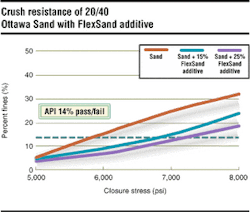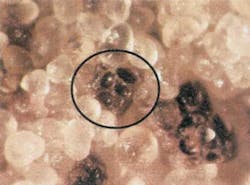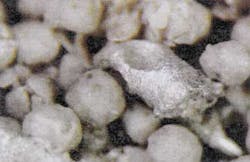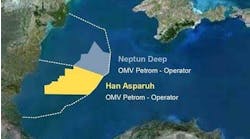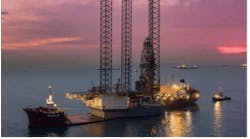FRACTURING TECHNOLOGY: Maintaining fracture conductivity while controlling formation flowback
Proppants for fracturing formations, such as sand, resin-coated sand, ceramic, and other materials currently are being used in order to maintain fracture conductivity. Also, additives such as fibers, thermo-plastics strips, and resin consolidation systems are introduced for flowback prevention.
A recently developed additive named FlexSand, is claimed to control proppant flowback and reduce the effect of stress on the proppant grains, while at the same time maintaining fracture conductivity. The product was developed by BJ Services Co. The developer created three grades of additives for various closure stresses. It can be applied to oil and gas wells with low, medium, and high closure stress ranges. These ranges are 250-1,750 psi with bottomhole temperatures up to 93° C for LS (low stress), 500-7,000 psi and bottomhole temperatures up to 135° C for MS (medium stress), and 6,000-12,000 psi and bottomhole temperatures up to 220° C for HS (high stress).
The process is to intermix similarly sized deformable particles within the proppant pack at which time upon closure, these particles "cushion" the proppant from damaging stresses. Deformation of the particles creates indentations in their surface, locking the proppant in place, thus increasing the resistance to proppant flowback.
Results and benefits have been a reduction in proppant crushing and fines generation, enhanced proppant performance under cyclic stress, equal or improved fracture conductivity when compared to previously used methods of proppant flowback and cyclic stress control, equal or improved proppant permeability, and an increase resistance to proppant flowback.
Case study I
An operator was preparing to fracture stimulate the Morrow formation at +/-8,000 ft. Because of expected high production rates, sand flowback was a concern. An offset operator was unable to produce at rates above 3 MMcf/d without experiencing sand flowback problems.
The use of the additive was proposed to eliminate the problem of proppant flowback. The well was fractured stimulated with 21,000 gallons of 65 quality binary foam carrying 24,500-lb 16/30 mesh frac sand and 4,500-lb FlexSand (15%).
Initial production was 7 MMcf/d and has now stabilized at 5 MMcf/d without sand production concerns. The operator considered the treatment a success.
Case study II
The Wasatch Formation has a tendency to produce moderate amounts of sand after stimulation. One severe case flowed back most of the proppant placed with two separate frac jobs, approximately 30,000 lb. An offset well was fracture stimulated with 60,000 lb. sand comprised of 15% FlexSand additive included throughout the entire treatment.
The user estimated the total post frac sand production at 150 lb. There was no other sand prod-uction from this well in the first 30 days of production. Gas production has been a pleasant surprise as well. The well tested 1,300-1,500 Mcf/d at 380 psi after the frac and has been put on production at 550 Mcf/d.
This well has maximized the capacity of the compressor in the field, and the operator is in the process of changing over to a larger compressor. A typical Was-atch producer in this area would sustain about 400 Mcf/d.
Case study III
The Selma Chalk formation has a tendency to produce sand after a propped fracture treatment. In the past, the operator has worked with the competition to provide a solution for proppant flowback problems. The product used at the time was successful in preventing sand production, however during the flowback of the fracturing fluids, the flowback product would occasionally plug up the choke and the surface equipment.
The user determined that when the fracture width was narrow, the flowback product used was trapping fines during production, reduced conductivity of the fracture. Over time this would result in a decline in gas production. BJ Services prepared 5,000 lb (15%) of the FlexSand additive to be added to the final proppant stage of the treatment. After treatment, no proppant has been produced back, and the customer considered the additive the solution to the problem.
